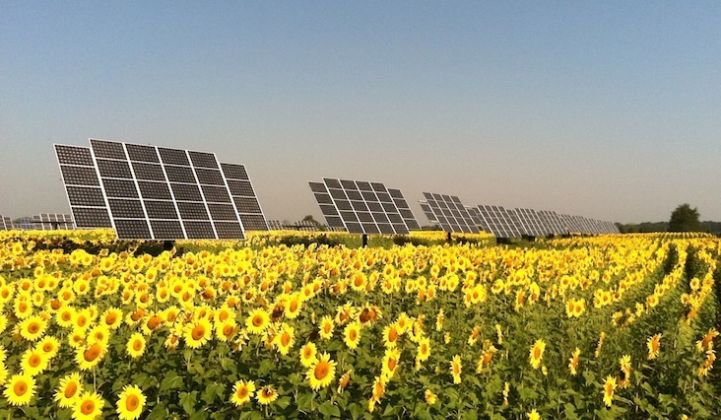“Innovation in technology and manufacturing is extremely important, but it is not enough. We have to do more. We have to look at balance-of-system costs,” said Minh Le, the Acting Deputy Program Manager of the Department of Energy’s Solar Technologies Program, including the SunShot Initiative. “One of the challenges [in solar] is that we have more than 18,000 local jurisdictions with permitting responsibilities. [...] More paperwork means more money and [higher] costs.”
At the MIT Energy Conference, Le spoke about the importance of reducing the cost of permitting and the time to interconnection. He called for streamlining solar processes at the local and state levels.
“Unlike physics, where we can fundamentally figure out the upper limit for the efficiency of solar cells, there is no such limit to bureaucracy." Pointing to Germany for inspiration, he continued: "Can we use IT solutions to simplify [solar] application processes?” .
In Germany in Q3 2011, the installed cost of solar was $2.80 per watt, far less than the installed cost in the United States, $5.20 per watt.
“The hardware costs are the same,” said Le. “Where is the difference? A lot of it is the soft costs.”
Financing structures and costs also differ. In the U.S., solar relies on tax incentives and tax equity.
“A relatively complicated nuance of solar financing in the U.S. relative to other parts of the world [is that] the U.S. government has chosen to finance solar with tax credits and accelerated depreciation,” said Craig Wetmore, Director of Acquisitions at CleanPath Ventures. “The cost of capital is a very important driver -- [and] the cost of capital is going up.”
For costs to decrease, the tax equity market needs to expand.
“We hope there will be more tax equity players in the market,” continued Wetmore. “We are starting to see corporations … that have money on the balance sheet and are tired of earning [low] returns [come into solar]. If these entities do come into the space and invest at reasonable rates, the [solar] market will continue to grow.”
OK, but we knew that already. Wetmore also made a few more controversial predictions.
“The near-term supply situation that has led to a huge drop in silicon module prices is going to come to an end. The reason is that the capital markets and, particularly, tax equity investors are starting to say that they have had enough exposure to the Suntechs and Trinas of the world, because if they do not think Suntech is going to be around in five or eight years because they are selling modules at below cost, they [will] not place those investments,” said Wetmore. “There could be a situation where the capital cost ricochets higher because the module cost has been so low. That is counterintuitive to what my friends at Suntech would tell me, but it is what we are hearing from our banking partners.”
He also believes that it is only a matter of time until First Solar is acquired.
“I am not sure how First Solar comes out of [its current challenges] in two or three years,” said Wetmore. “It is our sense that it will be acquired by GE or Siemens or another entity with a large balance sheet that will help the company weather the storm. I don’t think that in five years or even three years, that we will have 25 entities that produce PV [modules as] standalone entities. A lot of them will get gobbled up by entities with larger balance sheets.”
Finally, Tonio Buonassisi, an MIT Professor of Mechanical Engineering and the founder of MIT’s PV Research Laboratory, discussed five areas in which he believes solar technologists can and will continue to innovate: thinner wafers (e.g., AstroWatt, Ampulse, SiGen, Crystal Solar, Twin Creeks Technologies, and 1366 Technologies), higher efficiencies, novel manufacturing processes, TCAD simulations, and thin-film technologies.
“We keep hearing that the price of silicon modules is so low that thin-film modules can’t compete. But some of these new technologies haven’t had a chance to scale,” said Buonassisi. “There is a very good chance that in the next two to three years, we will see a thin film approach gain market share. We need investors with a thick stomach.”
Then again, Buonassisi is an alum of Evergreen Solar, whose post-IPO investors might wish they had thinner stomachs years ago.
***
Yoni Cohen has worked for greentech venture capital firms DBL Investors and Israel Cleantech Ventures and reported about environmental innovation for numerous publications. Follow Yoni on twitter @Cohen_Yoni.
Solar

Bold Words From the DOE, MIT, and VC on Solar’s Future
MIT Energy Conference speakers call for soft-cost reductions and predict that First Solar will be acquired.

Bold Words From the DOE, MIT, and VC on Solar’s Future
Photo Credit: photo courtesy of Convergence Energy, LLC, Steve Johnson
-
41Where Will DOE’s Loan Program Make the Next Climate Tech Investments?
-
15What the Frack Is Happening With Natural Gas Prices?
-
9With an Energy Crisis Brewing, No Peak in Sight for Emissions


